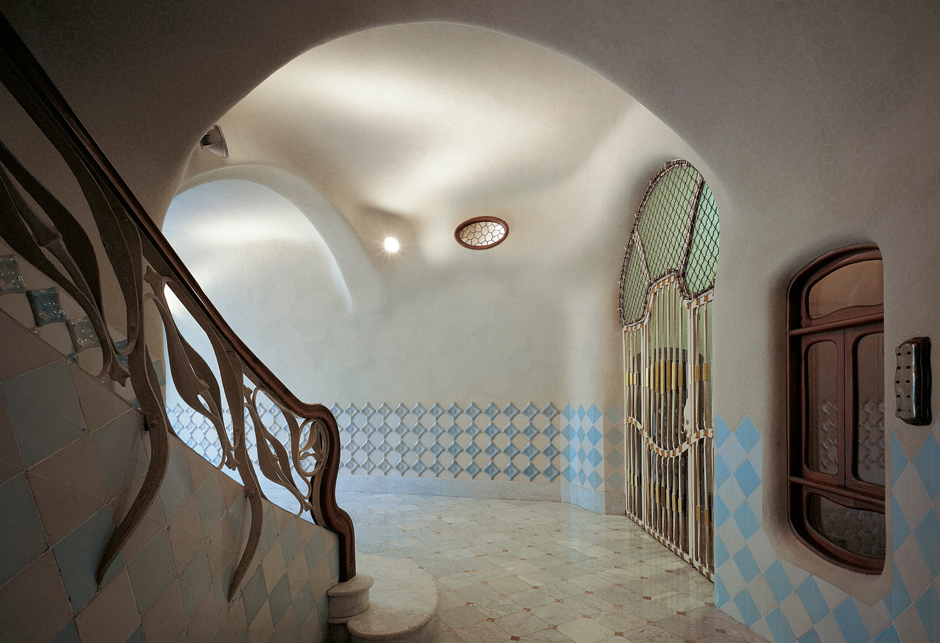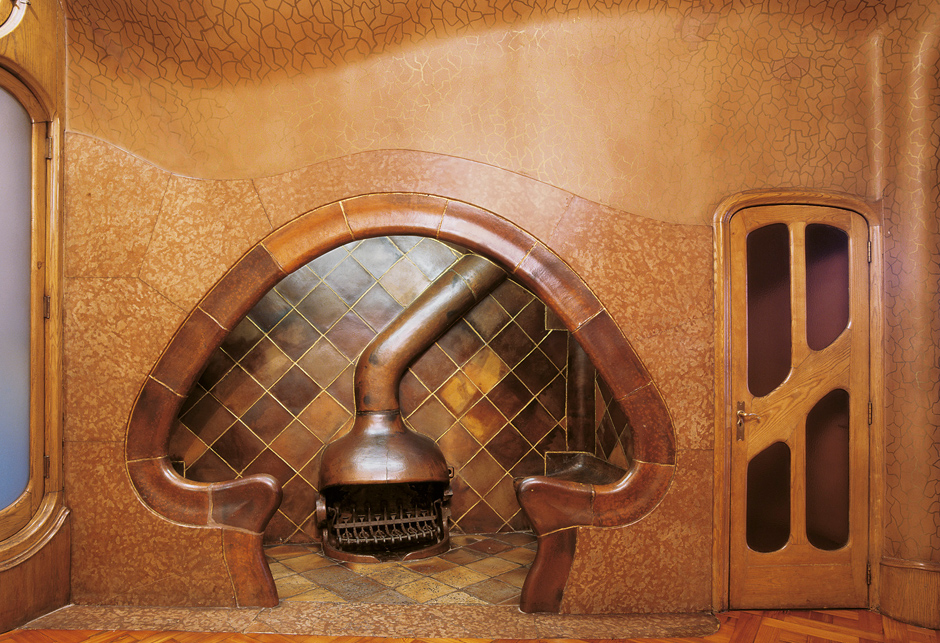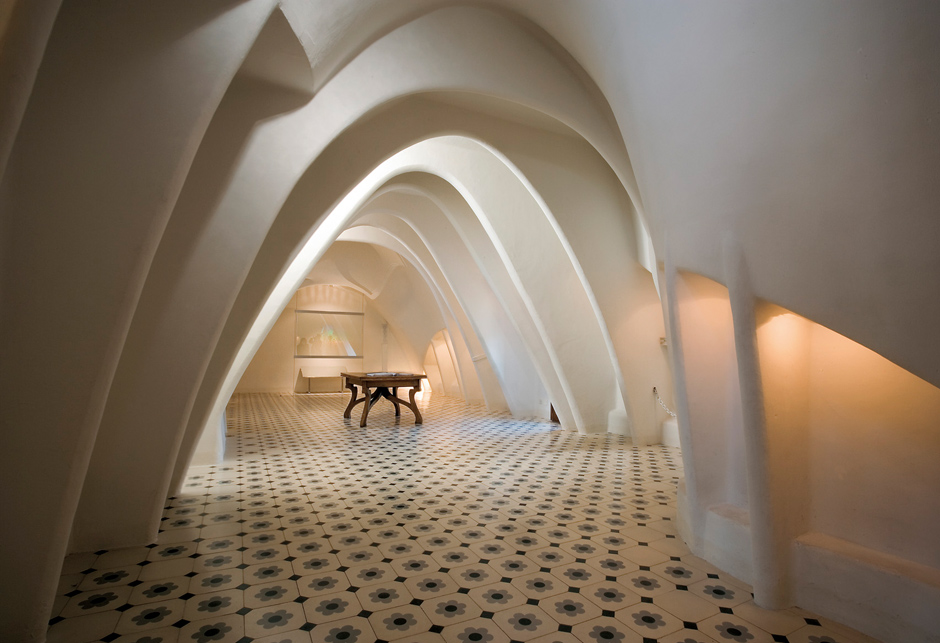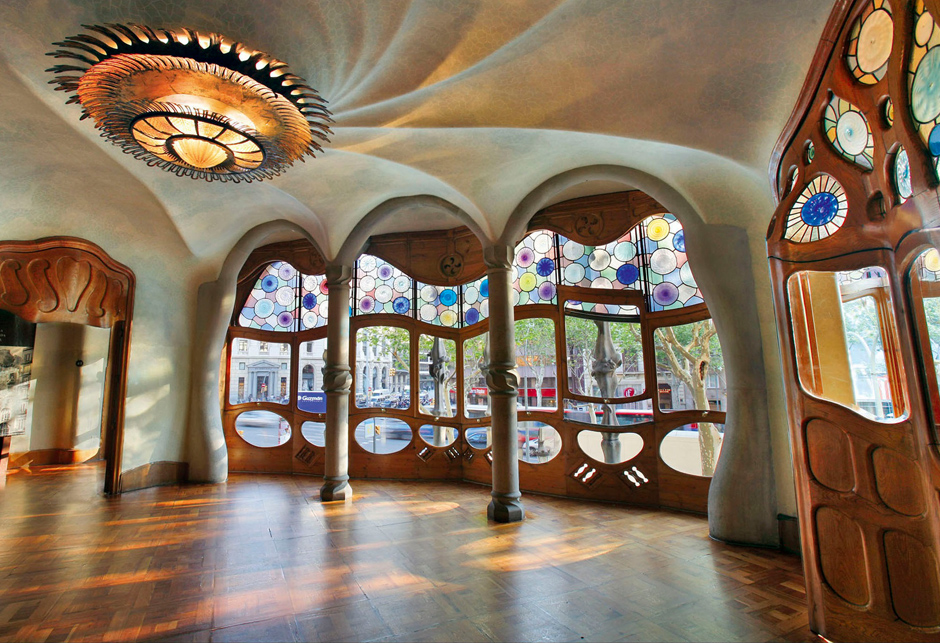Casa Batlló

Gaudí built one of his most important and best-known structures in a time of just one year and a half. In spite of what it might seem at first sight, the Batlló House was not a new building but the reform of an existing one. The very radical and brilliant transformation in the use of colours and shapes, which had never before been seen on a façade, quickly established this building as an icon of the new Barcelona.
The Batlló House, which is popularly and variously known as the House of the Bones, the House of the Masks, the House of the Yawns, and the House of the Dragon, symbolises to perfection the period of the architect’s greatest architectural maturity. Indeed, it represents the ideal combination of art and functionality, and of architecture and design, and it is a key building for an understanding of the significance of Catalan Modernisme.
THE “APPLE” OF DISCORD
Emili Sala Cortés built the house at Passeig de Gràcia, number 43, in 1877. At the turn of the century, this city block in the Eixample district became the site of a number of buildings by such famous architects as Josep Puig i Cadafalch (Amatller House) and Lluís Domènech i Montaner (Lleó-Morera House). While these buildings brought in new clients and were a mark of distinction for their owners, the city block where they stand was criticised by the satirical press which, in a play on words in the Catalan language, came to call it “The Apple of Discord”, referring to the rivalry between the architects and especially to the contrasting façades of their buildings here.
Gaudí was the last celebrated architect to go to work on this block and he had to carry out his commission with a knowledge of what his illustrious “neighbours” had already done. The building erected by Sala was purchased by the textile manufacturer Josep Batlló i Casanovas in 1903 and one year later he hired Gaudí to completely refurbish the building. And that is just what the architect did...

A FAÇADE OF CELEBRATION AND LEGEND
The façade of the Batlló House is known throughout the world for its unique composition full of fantasy and colour. This chromatism, together with the vertical undulations, has caused this building to be compared to Claude Monet’s series of Water Lilies oils. Others have related it to the elements of Carnival because the crown of the façade resembles a harlequin’s cap, the trencadís mosaic cladding is reminiscent of confetti, and the balconies look like carnival masks. The clearest allusion here, however, is to the legend of Saint George, with the roof of the building shaped like a dragon’s back, the cross on the end of the knight’s lance, the princess’s balcony in the shape of a blossoming flower, and the bones of the victims devoured by the dragon on the first floor.
Aside from such interpretations, this main façade is a compendium of original formal and structural ideas which are repeated in the rest of the building, like the fanciful chimneys on the roof terrace which are reminiscent of wild mushrooms; the rear façade with its ceramic trencadís mosaic of natural and geometrical shapes, or the splendid lightwell where Gaudí graduated the size of the windows and the colours of the ceramic cladding in a progressive combination that enhances the lighting of the whole interior.
LIVING INSIDE OF A DRAGON
The first storey is the principal floor or piano nobile, which was originally the residence of the Batlló family. Here the great hall stands out as a space full of light and sinuous shapes with views of Passeig de Gràcia. Gaudí gave it special attention, with an interesting arrangement of the ceilings and a very elaborate decoration, playing with lights and shadows in the various spaces and giving an undulating shape to all the partitions. The façade is made of stone here and there is a gallery where the windows once again have sinuous and completely different shapes while the pillars adopt the shape of bones with joints.
Above this principal floor, four floors of the building were for rental and a fifth floor was designed with attics as the area for servants and for storage. It is a very suggestive, evocative and pure space formed by a succession of catenary arches, which transport the visitor into the belly of the dragon. In the complete reform of the old building made by Emili Sala, Gaudí enlarged the central space, where the staircase and the lift are located, forming a lightwell that is covered with blueish tiles that provides greater intensity to the upper part and more brightness to the lower part. In this way the architect achieves an even distribution of light while conveying an unequivocal sensation of being at sea. For some it evokes Jules Verne’s book Twenty Thousand Leagues under the Sea.



A FOREST OF CHIMNEYS ON THE ROOF TERRACE
Two winding staircases provide access from the attics to the roof terrace, where imposing and surprising grouped chimneys were meticulously decorated with coloured glass trencadís mosaic. The roof terrace of the Batlló House is one of Gaudí’s most spectacular plastic arts creations. Built on the parabolic arches of the attics, it is a rectangular space divided in its centre by the skylights of the interior courtyards. In the front part there is a big room where the water tanks were installed, coinciding with the highest point of the façade. With this design, Gaudí succeeded in giving an aesthetic sense – the undulated scaled back of the dragon – to a functional requirement of his times, when running water did not have enough pressure to meet the required standards of convenience. If the view of the crown of the building as seen from the outside imitated the scales of a dragon, its inner side – which acts as the railing of the roof terrace – looks like the shell of a crab, with graduated tones of colour going from bright orange to white.
The four groups of chimneys on the roof terrace have a height of 6.10 metres and are covered with glass fragments and multi-coloured trencadís mosaics adorned with flower patterns. The whole stands halfway between the forest of chimneys which may be seen at the Güell Palace (1888) and the roof terrace of the Milà House (1910). The special design of the chimneys prevents backdraughts.

BELATED RECOGNITION
The unanimous recognition of the building’s inventiveness and beauty was slow in coming. The City Council’s annual artistic buildings competition denied its prize to it on two occasions, with the award going to the Lleó-Morera House, by Domènech i Montaner, and the school Col·legi Comtal, by Bonaventura Bassegoda i Amigó, respectively, in 1906 and 1907. The Batlló House finally received its well deserved recognition in 1962, when it was listed in the Barcelona City Council’s Heritage Catalogue. Subsequently, it was declared a Historic and Artistic Monument (a designation given by Spain to what is now called Cultural Interest Property) in 1969, and in 2005 it was listed as a World Heritage Site by UNESCO. In 2006 it received the “The Best in Heritage” prize granted by the Europa Nostra Awards, valuing the complete recovery and heritage restoration achieved through a wholly private financial effort.
OPENING HOURS
Monday to Sunday 09:00 - 21:00 h
HOW TO GET THERE
Bus: H10, V15, 7, 22, 24
Metro: L2 / L3 L4 - Passeig de Gràcia
FGC train: Provença station
RENFE train: Passeig de Gràcia station
TOURISTIC TRANSPORTS
Bus Turístic: North and South Route Casa Batlló – Fundació Antoni Tàpies
Barcelona City Tour: Stop 3 A, Passeig de Gràcia - Casa Batlló
Barcelona Guide Bureau: Gaudí Tour (guided tour pack to three Gaudí sites)